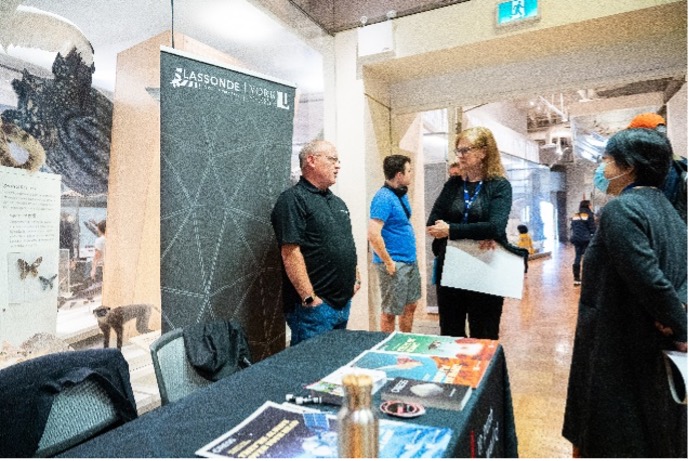
A milestone space achievement for York University’s Lassonde School of Engineering was shared with students and members of the public during an event at the Royal Ontario Museum (ROM) last month.
Lassonde recently celebrated landing a place in space history by contributing an essential scientific instrument to the National Aeronautics and Space Administration’s OSIRIS-REx – the first U.S-led space mission to successfully collect a sample from an asteroid – and shared details of the mission and its success with the community.
Last month, an information booth at the ROM occupied by members of Lassonde’s Centre for Research in Earth & Space Science (CRESS) provided an opportunity for ROM visitors to engage with the efforts of Lassonde faculty who were involved with the OSIRIS-REx mission.

The mission involved the OSIRIS-REx craft being launched into space in 2016, with the goal of investigation and gathering samples from an asteroid named Bennu. On Sept. 24 of this year, the OSIRIS-REx successfully returned and delivered samples of Bennu to a desert region in Utah, where researchers were waiting with anticipation. Samples retrieved from Bennu will undergo extensive analysis, aiming to uncover details of the Earth and solar system’s ancient history.
The OSIRIS-REx mission marks a monumental achievement for Lassonde, as several Faculty researchers led the ideation, design and development of the OSIRIS-REx Laser Altimeter (OLA), a scientific instrument responsible for important tasks such as helping to choose a sampling site, supporting spacecraft navigation and collecting data used to create a realistic shape model for scientific analyses.
Working with the support of the Canadian Space Agency, Michael Daly, principal investigator of OLA and director of CRESS at Lassonde, led OLA from first concept through to the design and operations phases. The team also included expert researchers from various institutions, as well as James Freemantle, project management support and research associate at CRESS, and Jeff Seabrook, deputy instrument scientist and research associate at CRESS. (Freemantle and Seabrook were present at the recent ROM information booth to engage with community members about their, and Lassonde’s, work.)
OLA was first conceptualized by Daly more than a decade ago during his time at Canadian space technology company MDA. The company continued to support the project by building OLA with help from Teledyne Optech, a leader in the design, development and manufacturing of advanced lidar instruments.
In addition to the community event at the ROM on Sept. 26, Freemantle and Seabrook offered the York community on the Keele Campus an opportunity to learn more with an information booth stationed in the lobby of the Bergeron Centre for Engineering Excellence.
Learn more about the event, and the mission, here.
